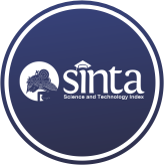Penggunaan YOLOv8 untuk Deteksi Penyakit Daun Kopi
(1) Universitas Kristen Satya Wacana, Salatiga, Jawa Tengah, Indonesia
(2) Universitas Kristen Satya Wacana, Salatiga, Jawa Tengah, Indonesia
(*) Corresponding Author
Abstract
Full Text:
PDFReferences
M. Odhiambo, “Coffee leaf diseases.” Accessed: Nov. 10, 2023. [Online]. Available: https://www.kaggle.com/datasets/badasstechie/coffee-leaf-diseases
A. N. Sugandi and B. Hartono, “Implementasi Pengolahan Citra pada Quadcopter untuk Deteksi Manusia Menggunakan Algoritma YOLO,” Jul. 2022.
H. Rezatofighi, N. Tsoi, J. Gwak, A. Sadeghian, I. Reid, and S. Savarese, “Generalized Intersection over Union: A Metric and A Loss for Bounding Box Regression,” Feb. 2019, Accessed: Feb. 06, 2024. [Online]. Available: http://arxiv.org/abs/1902.09630
H. Hassan et al., “Review and classification of AI-enabled COVID-19 CT imaging models based on computer vision tasks,” Feb. 01, 2022, Elsevier Ltd. doi: 10.1016/j.compbiomed.2021.105123.
A. Saleh, M. Sheaves, D. Jerry, and M. Rahimi Azghadi, “Applications of deep learning in fish habitat monitoring: A tutorial and survey,” Mar. 15, 2024, Elsevier Ltd. doi: 10.1016/j.eswa.2023.121841.
C. Dewi, H. Dwi Purnomo, B. Kristanto, D. Hartomo, S. Zaiton, and M. Hashim, “Utilizing the YOLOv8 Model for Accurate Hand Gesture Recognition with Complex Background,” 2017, doi: 10.1016/j.cviu.2017.00.000.
F. Sultana, A. Sufian, and P. Dutta, “A Review of Object Detection Models based on Convolutional Neural Network,” May 2019, doi: 10.1007/978-981-15-4288-6_1.
C. Dewi, R. C. Chen, Hendry, and Y. T. Liu, “Similar Music Instrument Detection via Deep Convolution YOLO-Generative Adversarial Network,” in 2019 IEEE 10th International Conference on Awareness Science and Technology, iCAST 2019 - Proceedings, Institute of Electrical and Electronics Engineers Inc., Oct. 2019. doi: 10.1109/ICAwST.2019.8923404.
F. Jacob Solawetz, “What is YOLOv8? The Ultimate Guide. [2024].” Accessed: Feb. 08, 2024. [Online]. Available: https://blog.roboflow.com/whats-new-in-yolov8/
J. Terven, D.-M. Córdova-Esparza, and J.-A. Romero-González, “A Comprehensive Review of YOLO Architectures in Computer Vision: From YOLOv1 to YOLOv8 and YOLO-NAS,” Dec. 01, 2023, Multidisciplinary Digital Publishing Institute (MDPI). doi: 10.3390/make5040083.
C. Dewi, D. Manongga, Hendry, E. Mailoa, and K. D. Hartomo, “Deep Learning and YOLOv8 Utilized in an Accurate Face Mask Detection System,” Big Data and Cognitive Computing, vol. 8, no. 1, Jan. 2024, doi: 10.3390/bdcc8010009.
RangeKing, “Brief summary of YOLOv8 model structure,” Jan. 10, 2023. Accessed: May 22, 2024. [Online]. Available: https://github.com/ultralytics/ultralytics/issues/189.
R. Padilla, S. L. Netto, E. A. B. Da Silva, and S. L. Netto, “A Survey on Performance Metrics for Object-Detection Algorithms”, doi: 10.1109/IWSSIP48289.2020.
DOI: https://doi.org/10.30645/kesatria.v5i4.501
DOI (PDF): https://doi.org/10.30645/kesatria.v5i4.501.g496
Refbacks
- There are currently no refbacks.
Published Papers Indexed/Abstracted By:














